Recently I came across a beautiful photograph in a secondhand book store and snapped it up for my collection. Usually I don’t blog about items that I’ve only recently purchased but this I thought was an exception. I give you – four Dunedin children and their pet cat.
I wanted to share a light and fun post to contrast with my recent opinion piece on the changing names of military conflicts. History Geek shouldn’t always be so serious and what better way to prove it than to share a vintage cat photo and look for some cute stories about what it was like to have a pet cat in late nineteenth century New Zealand. Surely that would be a lovely topic. Or so I thought. I don’t want to let the cat out of the bag but I have to give you a warning, this post may start off with plenty of “awwww” but some of the stories I found take a rather disturbing twist. Feline lovers read on at your own risk.
First of all lets take a look at the photograph. It was taken by F. Butterfield & Co. in Dunedin, New Zealand. It caught my attention because it I have an interest in South Island photographers, it is relatively uncommon to find outdoor family portraits from that period, and even rarer to find one with a cat in it.
So when exactly was it taken? Well, according to the Auckland Library’s fantastic database of New Zealand photographers it appears that F. Butterfield was operating in Dunedin from 1893 until 1898 when he moved to Temuka. Which means the photograph was most likely taken between 115 and 120 years ago. Just for fun I used this calculator to see how old in cat years this feline would be if it was still alive. If the cat was say, five years old when the photograph was taken then in cat years it would be 477 – 497 years old! So for a cat this would be a bit like us looking at a photograph of William Shakespeare’s mother or father. Cats have it so good. OR SO I THOUGHT…
For those who are familiar with this blog, I usually like to take an old item from my collection and use it as an excuse to explore an area of history. This time I thought I’d spend a few hours trawling through Papers Past and look for any references to pet cats in the Victoria-era and compose a list of names, so that should anyone be writing a book or a script and be in need for a list of period-appropriate pet cat names then they might find this post useful. Here you go:
Tabby, Flossy, Minnie, Susy, Tommy, Whitey, Seraphic, Tom, Topsy, Kitty, Lyla, Jack, Rose, Snowdrop, Jenny, Charley, Torty, Felis, Scobie, Gip, Chati, Toss, Jupiter, Maia, Clementina, Angelina, Tiger, Minnie, Muffy, Darky, Tab and Sandy. Also Lucifer (a French cat that went missing during the Franco-Prussian War).
While searching for these names I ended up finding a lot more than I bargained for – I stumbled across an absolute gem in the form of a series of letters from children to the Otago Witness. They give a fascinating insight into the life of children in Victorian New Zealand. I’ve since found out that there has even been a book published about them. So what should a bored History Geek like yours truly do with such a fantastic resource? Well I spent an entire evening reading through them looking for any references to cats. The result was a surprising insight into what life was like for children and their pet cats over one hundred years ago. I hope you enjoy reading these glimpses into forgotten felines as much as I did.
Unfortunately not all the stories are as cute, some of them highlight the harsh realities faced by both children and pets alike. This letter from eleven year old Ada from Mount Cargill is particularly heart breaking.
This is the part where cat lovers really might want to look away….
At first I was completely shocked by this story, but then I started finding many similar references to cat drownings.
While these scenes sound absolutely horrific to us today it seems that in Victorian times it was common practice to drown injured or unwanted cats. These nonchalant admissions from children writing to their local newspaper conflict with our understanding of animal cruelty, but there is still something to be learned from them.
While I was initially shocked by some of these letters from “Little Folks” I now appreciate them for what they are, an insight into the daily life of children that would grow up to be suffragettes, soldiers, parents and grandparents. As abhorrent as drowning a cat may seem and as horrific as it must have been to witness, it was part of reality for those children.
In the late nineteenth century there were comparatively few options for getting rid of unwanted pets. Victorian New Zealand certainly didn’t have mobile desexing clinics and the likes of the SPCA were very much in their infancy in cities and towns that were still considered the frontier of the British Empire. Yet even today tens of thousands of pets are still euthanized annually by the SPCA in New Zealand. This is despite easy ways to prevent unwanted animal births.
Of course today anyone who would drown an animal would be rightly vilified and prosecuted, but I have always believed that it is unfair to judge those in another time by the standards of today. Researching this post reminded me of that.
As a side note, New Zealand’s first SPCA was formed in 1882 in Dunedin – the same place where the photograph above was taken and the same place that was home to both ‘Dot’ and the Otago Witness. If you feel generous then why not send the Dunedin SPCA a donation to help them continue the good work they started back then.
© Lemuel Lyes
Categories: Dunedin, Photography, Uncategorized
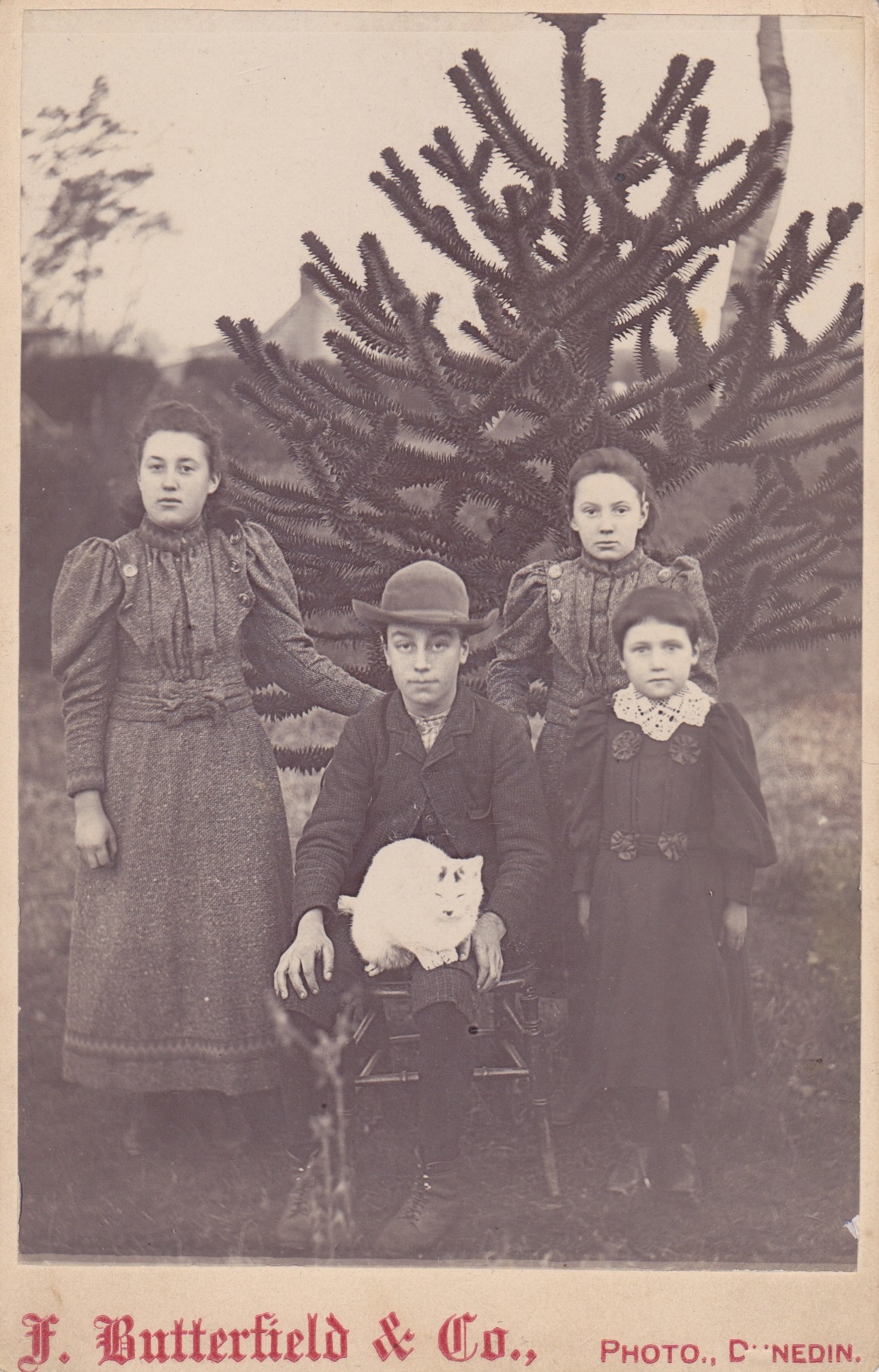
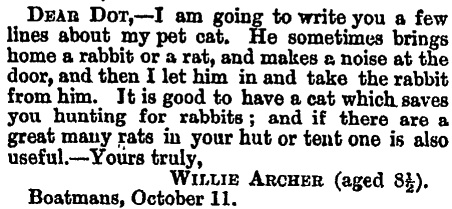

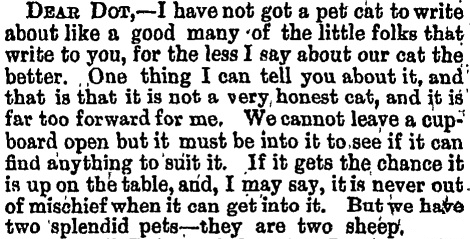
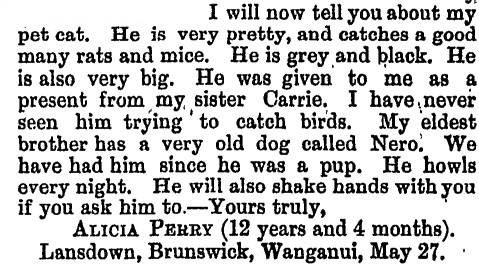
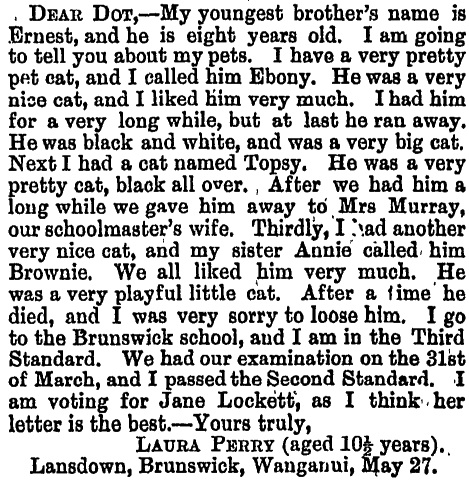
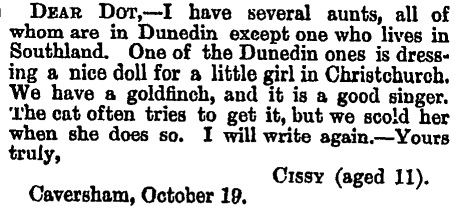
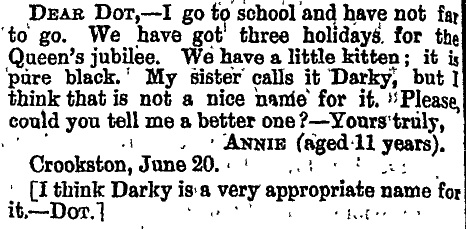
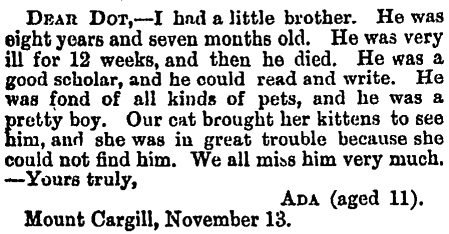

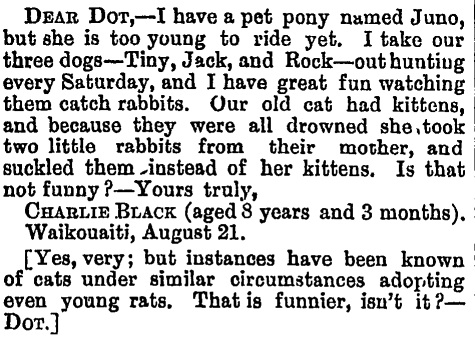
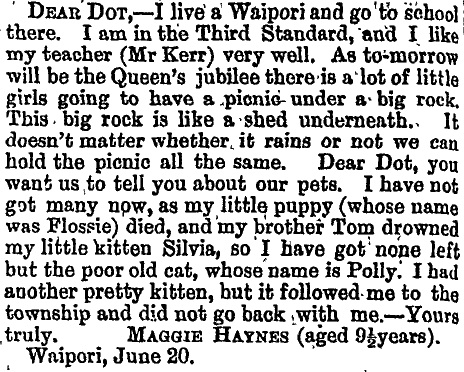

This is fascinating.
“… my brother Tom drowned my little kitten Silvia”. I wonder how old Tom was and whether this was anact of spite against his ister. Do you think he grew up to be a serial killer??
This is a fascinating post, Lemuel. I remember as a child in the 1970s, being horrified when a friend of mine’s dad, who was a pharmacist and I now think should have known better, drowned an entire litter of kittens because one of them had conjunctivitis. His argument was that the illness spread easily and would blind the kittens but I think he was just too mean with money to take them to a vet to get proper treatment.
Back then they of course didn’t have access to a SPCA to give the cats away to, or likely even a vet who could kill the animals in a more humane manner, so in most instances it seems that drowning was simply a common and acceptable way at the time to get rid of injured or unwanted animals. I suspect also that this happened to a lot of kittens as presumably it was a lot more difficult to desex your pet back then. So if I had to guess, I’d say that the odds are that Tom wasn’t being spiteful. That said, while researching for this post I did come across occasional incidents where some cats were treated in a way that even at the time was considered abuse.
I always find it amazing to see how something can go from being perfectly acceptable to absolutely despised (or vice versa) in only a couple of generations or even less. Gives me a little bit of faith that perhaps human society is slowly evolving into something better.
Me too. I am optimistic about our future in that department.
PS Can you add the link to your blog that allows us to get the posts via email? I keep missing yours as I cannot get time to go through the reader often enough.
Good idea! I think the sidebar was well overdue for a makeover. Will also be adding a blogroll soon!
I’ll look out for it. Thanks Lemuel!